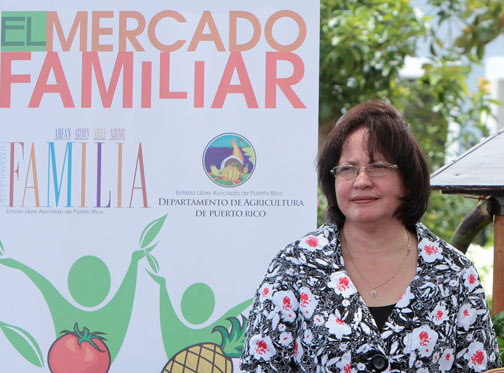P.R.’s agriculture sector bright spot in local economy

Mired in recession and awaiting a fix for its huge debt crisis, Puerto Rico has one bright spot in the local economy: Agriculture.
With help from the government, this sector is contributing new jobs, income, and agricultural products that are boosting the island’s tenuous food security.
Gross agricultural income rose 24 percent from $739 million in Fiscal Year 2012 to $919 million in Fiscal 2014, the highest income ever reported, according to Secretary of Agriculture Myrna Comas Pagan.
In 2015, “we reached 8,000 new jobs in agriculture. That sets a precedent,” she said.
“It is the comeback of agriculture. It is a fervor we have awakened through increased awareness of the importance of strengthening Puerto Rico’s food security.”
More than 80 percent of the food Puerto Rico consumes is imported.
Comas said more people are turning to the Agriculture Department to apply for the “competitive advantages” the government offers through salary subsidies, incentives, and investments in infrastructure.
This year, the agency is concentrating its efforts on expanding rice cultivation and extending the network of Farmers Family Markets to cover the entire island.
The last time Puerto Rico grew rice was in the 1980s. Rice cultivation was resurrected in 2013 with the kick-off of an experimental project to benefit the island’s school lunch program. The project produced 2.1 million pounds of rice and is now being expanded to supply consumers, Comas said.
The Farmers Family Market, a collaboration with the Department of the Family, aims to increase farm sales and boost nutrition by encouraging the public, including food stamp beneficiaries, to buy fresh, locally grown food directly from farmers in their communities. Under the program, food stamp recipients get an extra $10 to $12 to use exclusively to buy fruits and fresh produce at Family Markets. Currently, 44 of Puerto Rico’s 78 townships hold these markets regularly with sales surpassing $35 million since the program’s beginning in 2013.
Another area the department is focusing on is cane sugar with a plan that ultimately aims at producing 80 percent of the blackstrap molasses used by the island’s rum industry and currently imported from the United States.
The agency’s thrust over the past three years has been to “promote farm innovation, transform the agricultural market, guarantee our food security and ensure that our products are effectively exported,” Comas said.
It has tackled land use, the condition of farms, marketing and farm education. Comas said that as part of the land use plan some 636,847 acres were identified as protected farm land and agricultural preserves boosted by 10 percent. The Land Authority, part of the Agriculture umbrella, granted 67 titles and leased 64 farms under its family farm program. Abandoned farms have been restored and fallow lands put to use.
The agency has nurtured links between farmers and institutional markets (locally grown products now make up 60 percent of the school lunch tray) and regular distribution channels such as food distributors, service companies, manufacturers, and retailers.
“Plus, we set up sale points for farm products in malls, government agencies, the Urban Train and fairs around the island,” Comas said in response to written questions submitted by News Is My Business.
Among other efforts, the Agriculture department has promoted orchards among youths and developed a mobile app to publicize the Fishing Route through information on fishing areas and markets. With the Tourism Co., it has promoted the establishment of agritourism projects such as Hacienda Tres in Adjuntas which won recognition from the World Tourism Organization (UNWTO).
“We continue leading the way to job creation and strengthening Puerto Rico’s food security,” Comas said.
“It is everyone’s responsibility, from consumers to farmers. To the extent that we contribute to local food production, we will be strengthening food security.”













